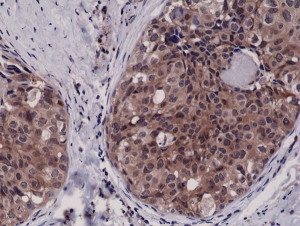
Immunohistochemical staining of formalin fixed and paraffin embedded human breast cancer tissue sections using Anti-Caspase-3 RM250 at a 1:2500 dilution.
anti-Caspase-3 (human), Rabbit Monoclonal (RM250)
REV-31-1130-00
ApplicationsWestern Blot, ImmunoHistoChemistry
Product group Antibodies
ReactivityHuman
TargetCASP3
Overview
- SupplierRevMAb Biosciences
- Product Nameanti-Caspase-3 (human), Rabbit Monoclonal (RM250)
- Delivery Days Customer10
- ApplicationsWestern Blot, ImmunoHistoChemistry
- CertificationResearch Use Only
- ClonalityMonoclonal
- Clone IDRM250
- Gene ID836
- Target nameCASP3
- Target descriptioncaspase 3
- Target synonymsCPP32, CPP32B, SCA-1, caspase-3, CASP-3, CPP-32, PARP cleavage protease, SREBP cleavage activity 1, apopain, caspase 3, apoptosis-related cysteine peptidase, caspase 3, apoptosis-related cysteine protease, cysteine protease CPP32, procaspase3, protein Yama
- HostRabbit
- IsotypeIgG
- Protein IDP42574
- Protein NameCaspase-3
- Scientific DescriptionCaspase-3 is a member of the interleukin-1 beta-converting enzyme family. This cytoplasmic caspase functions as a heterotetramer and has two isoforms (one acts as a dominant negative inhibitor). The proform of this caspase is approximately 32 kD. Activation of caspase-3 requires proteolytic processing of its inactive pro-form into activated p17 and p12 fragments. Caspase-3 is a critical executioner of apoptosis, as it is either partially or totally responsible for the proteolytic cleavage of many key proteins, such as the nuclear enzyme poly (ADP-ribose) polymerase (PARP). Caspase-3 is inhibited by c-IAP1, c-IAP2, XIAP, survivin and Livin and activated by Caspase-6, -8 , and -10, granzyme B, Apaf-1 by cleavage into large p17 and small p12 subunits. Caspase-3 has been shown to cleave PARP, huntingtin, androgen receptor, atrophin-1, DNA- PKcs, D4-GDI, hnRNPs C1/C2, U1snRNP, PKC delta, ATM, fodrin, gelsolin, ICAD, RIP, X-IAP, STAT1, topoisomerase I, vimentin, Rb, lamin B, mdm2, and beta-catenin. Caspase-3 is important for normal brain development as well as its typical role in apoptosis, where it is responsible for chromatin condensation and DNA fragmentation. Elevated levels of a fragment of Caspase-3, p17, in the bloodstream is a sign of a recent myocardial infarction. Caspase-3 may play a role in embryonic and hematopoietic stem cell differentiation. - Recombinant Antibody. This antibody reacts to human full length caspase-3 (35 kDa) and the large fragment of caspase-3 resulting from cleavage (17 kDa). Applications: WB, IHC. Source: Rabbit. Liquid. 50% Glycerol/PBS with 1% BSA and 0.09% sodium azide. Caspase-3 is a member of the interleukin-1 beta-converting enzyme family. This cytoplasmic caspase functions as a heterotetramer and has two isoforms (one acts as a dominant negative inhibitor). The proform of this caspase is approximately 32 kD. Activation of caspase-3 requires proteolytic processing of its inactive pro-form into activated p17 and p12 fragments. Caspase-3 is a critical executioner of apoptosis, as it is either partially or totally responsible for the proteolytic cleavage of many key proteins, such as the nuclear enzyme poly (ADP-ribose) polymerase (PARP). Caspase-3 is inhibited by c-IAP1, c-IAP2, XIAP, survivin and Livin and activated by Caspase-6, -8 , and -10, granzyme B, Apaf-1 by cleavage into large p17 and small p12 subunits. Caspase-3 has been shown to cleave PARP, huntingtin, androgen receptor, atrophin-1, DNA- PKcs, D4-GDI, hnRNPs C1/C2, U1snRNP, PKC delta, ATM, fodrin, gelsolin, ICAD, RIP, X-IAP, STAT1, topoisomerase I, vimentin, Rb, lamin B, mdm2, and beta-catenin. Caspase-3 is important for normal brain development as well as its typical role in apoptosis, where it is responsible for chromatin condensation and DNA fragmentation. Elevated levels of a fragment of Caspase-3, p17, in the bloodstream is a sign of a recent myocardial infarction. Caspase-3 may play a role in embryonic and hematopoietic stem cell differentiation.
- ReactivityHuman
- Storage Instruction-20°C
- UNSPSC12352203






